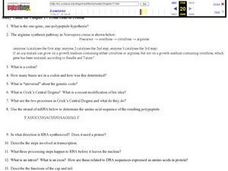Amoeba Sisters
Protein Synthesis (Updated)
Explore the steps of transcription and translation in protein synthesis! This video explains several reasons why proteins are so important before explaining the roles of mRNA, rRNA, and tRNA in the steps of protein synthesis! Expand...
Amoeba Sisters
Protein Synthesis: Before the Bell Biology
Time before the bell to try several protein synthesis questions with the Amoeba Sisters? You'll also get answers complete with illustrations and explanations while chill music plays in the background. It's a valuable way to use those...
Curated Video
Protein Synthesis
Proteins are made of a long chain of amino acids, which has been coded for by DNA. The order of the bases of DNA determines which protein is made, by coding for a specific order of amino acids. This is protein synthesis, and in this...
Curated Video
Explanation and Animation of Protein Synthesis: Translation
This video will explain and illustrate all steps of protein synthesis, starting with processing the RNA, followed by making a protein at the ribosomes (translation).
Curated Video
How are Proteins Made? - Transcription and Translation Explained #66
This video covers: - The two steps of protein synthesis: transcription and translation - Transcription is the production of mRNA, which is a copy of a gene - Translation is the production of a sequence of amino acids (a polypeptide)...
Curated Video
Protein Synthesis | Cells | Biology | FuseSchool
Protein Synthesis | Cells | Biology | FuseSchool Proteins are made of a long chain of amino acids, which has been coded for by DNA. The order of the bases of DNA determines which protein is made, by coding for a specific order of amino...
Ancient Lights Media
Cells - Ribosomes
Cell Structure and Function Set: 10. This clip looks at the structure of ribosomes and examines how they facilitate protein synthesis during the translation of M-RNA.
Catalyst University
Aminoacyl tRNA Synthetase Charging the Amino Acid
Aminoacyl tRNA Synthetase Charging the Amino Acid
Catalyst University
The Rough Endoplasmic Reticulum and Golgi Apparatus
The Rough Endoplasmic Reticulum and Golgi Apparatus
Amoeba Sisters
Protein Synthesis
Can your class visualize how proteins synthesize? Take a tour of the all-important process of protein synthesis to discover why our bodies depend on it. A video from an animated biology playlist covers transcription and translation, as...
FuseSchool
Protein Synthesis
Your body determines which proteins are made based on the code in your DNA. A Fuse School video explains how protein synthesis works. It starts with DNA, moves through transcription, RNA, mRNA, completes translation, tRNA, and finally...
Amoeba Sisters
Protein Synthesis and the Lean, Mean Ribosome Machines
Don't copy from each other, unless you are DNA — in which case, please make an exact copy. The video explains protein synthesis including the difference in transcription and translation. It touches on codon and how reading three bases at...
Curated OER
Protein Synthesis Worksheet
In this protein synthesis worksheet, students complete 17 questions about making proteins through the process of transcription and translation. They use a sample of DNA to make a protein using a given tRNA dictionary.
Curated OER
Protein Synthesis
For this protein synthesis worksheet, high schoolers identify the proper amino acids given the mRNA codons. They also identify the mRNA codon given the DNA code and the amino acid it codes for. Students answer questions about protein...
Curated OER
Protein Synthesis
In this protein synthesis worksheet, students use a given strand of DNA to write the complimentary base pairs. They transcribe the message to the RNA and then they translate the message into the proper amino acids using the codons on the...
Curated OER
Protein Synthesis
In this science related worksheet, students study, locate and answer ten multiple choice questions dealing with protein synthesis.
Curated OER
Protein Synthesis Worksheet
Future geneticists use base pairing rules to build DNA and RNA polypeptide strands, and then explain both transcription and translation. Although the chains themselves are a little blurry, there is plenty of room in them for learners to...
Curated OER
Protein Synthesis
In this biology worksheet, learners complete a crossword puzzle with 35 questions on protein synthesis. They identify the different parts of the cell involved in the process.
Curated OER
DNA, RNA, Protein Synthesis, & Mutation
In this biology worksheet, students identify and label the diagram shown by stating what each part of the diagram represents on the line. Then they use the DNA strand as the original strand and complete the data table. Students also...
Curated OER
From Gene to Protein Study Guide
In this biology worksheet, students review and answer different questions based upon the molecules of DNA and RNA. They look at the specific protein order of the DNA strand and its synthesis.
Teacher's Pet
Mutations in DNA
A human genome accumulates approximately 64 mutations per generation. The video explains the four types of mutations in DNA and their importance—or lack of importance. It incorporates knowledge about protein synthesis and combines it...















